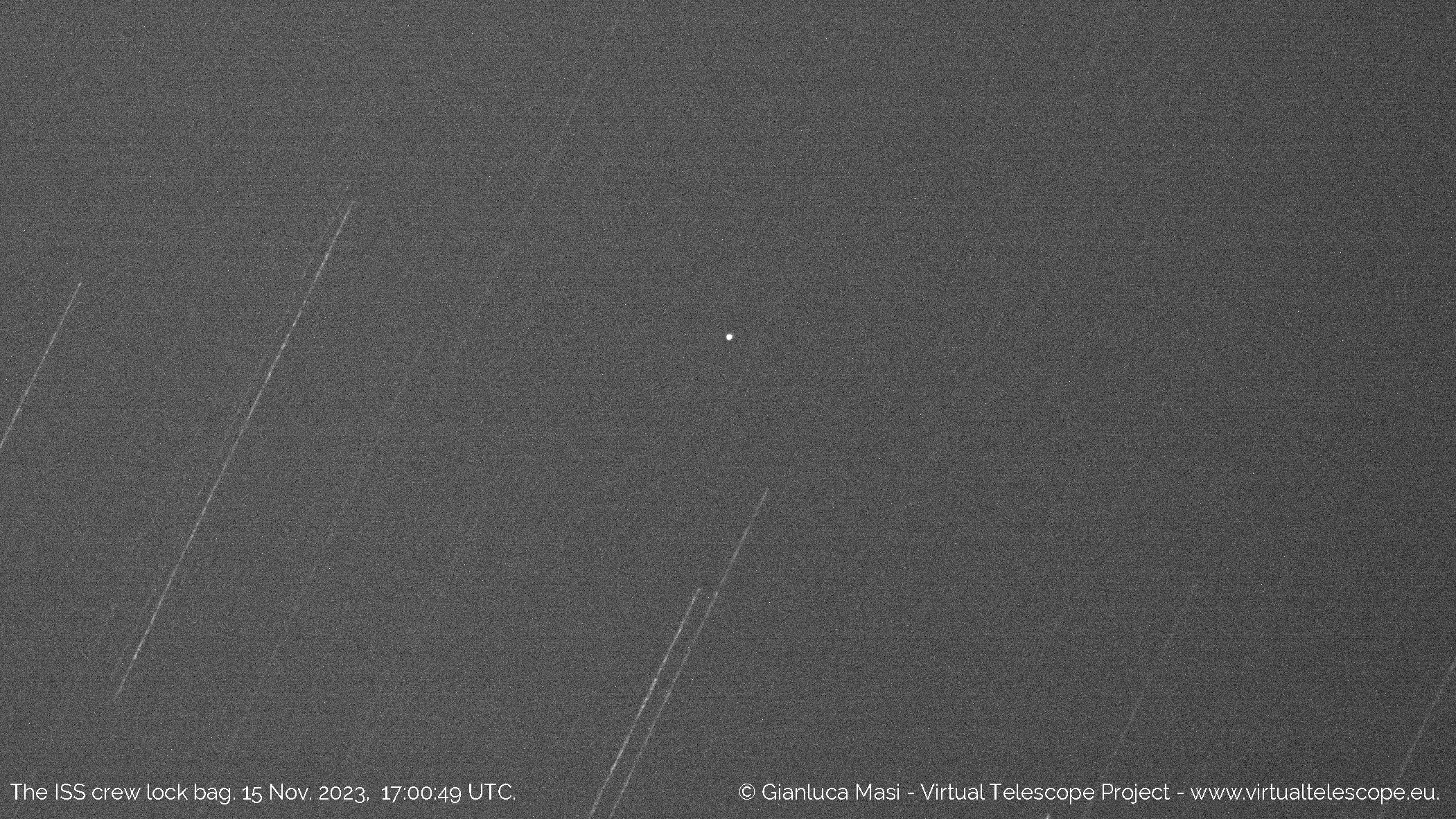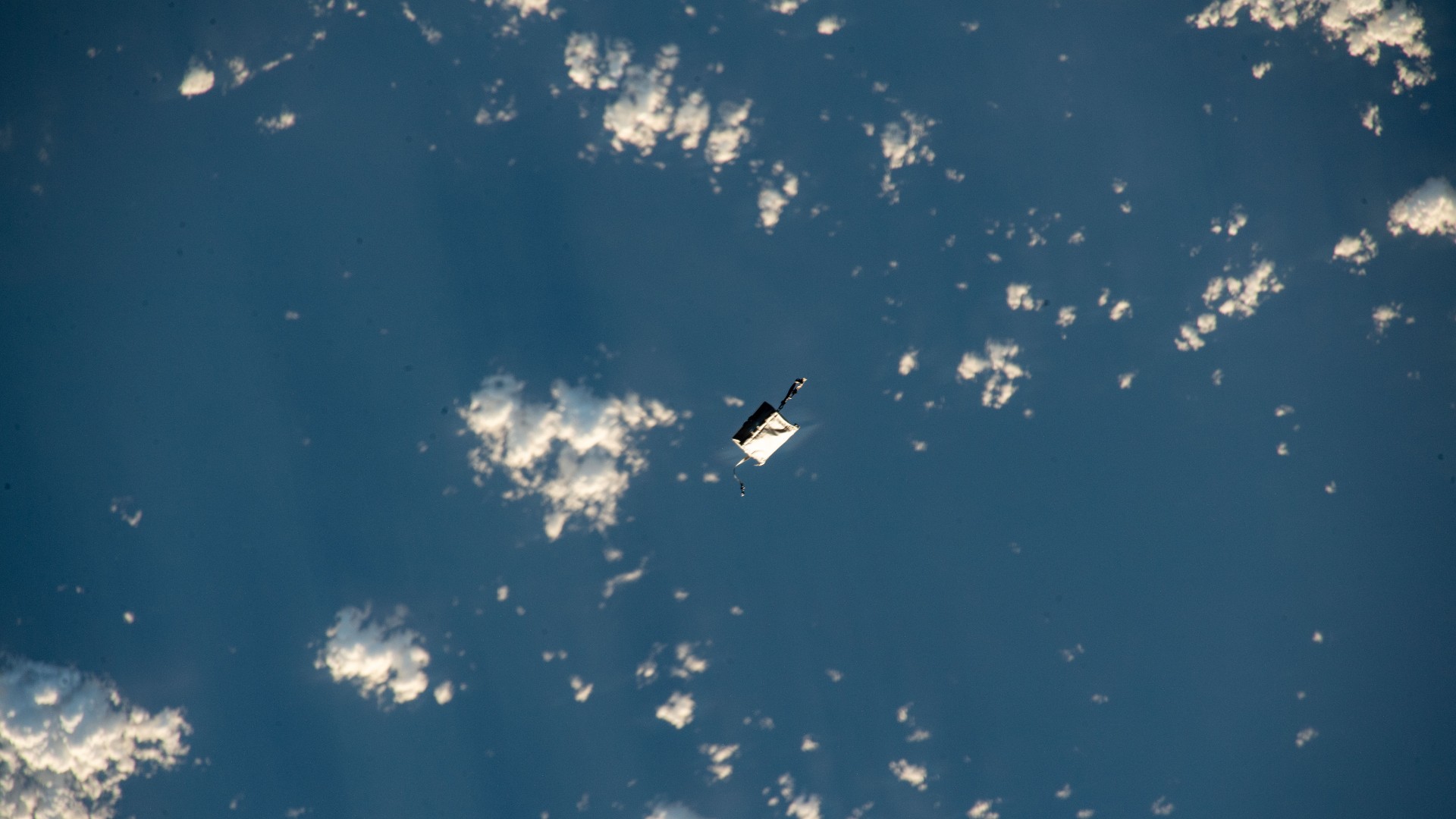Lost astronaut tool bag from ISS shines in new telescope image (photo)
You can even spot it with binoculars.

A lost tool bag in space shines brightly in a new image taken from Rome.
Two astronauts spacewalking on the International Space Station harmlessly lost grip of a tool bag during a Nov. 1 spacewalk. The shiny object, visible in binoculars, showed up in footage taken by the Virtual Telescope Project on Wednesday (Nov. 15).
"The image above comes from a single 2-second exposure," project founder Gianluca Masi wrote in a statement, alongside the image. "The object looks like a sharp dot of light in the center, as the telescope tracked it, so stars left long trails on the background."
Related: Astronauts dropped a tool bag during an ISS spacewalk, and you can see it with binoculars
NASA astronauts Jasmin Moghbeli and Loral O'Hara were doing a challenging solar array part replacement when the tool bag was "inadvertently lost," the agency wrote in a Nov. 1 statement.
"Flight controllers spotted the tool bag using external station cameras. The tools were not needed for the remainder of the spacewalk," agency officials wrote. "Mission Control analyzed the bag's trajectory and determined that risk of recontacting the station is low — and that the onboard crew and space station are safe — with no action required."
Related: How often does the International Space Station have to dodge space debris?
Get the Space.com Newsletter
Breaking space news, the latest updates on rocket launches, skywatching events and more!

The stray tool bag will float around our planet for a few months, until tendrils of Earth's atmosphere pull it back for a safe burn-up high above the surface at roughly 70 miles (113 kilometers) in altitude. The bag was roughly 258 miles (415 kilometers) above Earth as of last week.
For now, the tool bag has a U.S. Space Force designation 58229/1998–067WC in its cataloging system for artificial objects, Harvard & Smithsonian Center for Astrophysics astronomer Jonathan McDowell (who also tracks space launches, landings and re-entries) shared on X, formerly Twitter.
NASA carefully monitors any space debris that comes within a multi-mile "pizza box" shape surrounding the space station; the orbiting complex has had to move out of the way nearly 40 times in its 24 years of service, although the agency uses a conservative 1-in-10000 chance threshold to keep crews safe.
As the number of launches and satellites in orbit continue to grow, the potential for space junk is also climbing. Models from the European Space Agency suggest there may be something like 130 million pieces of space debris larger than a millimeter. Trackable space items are far fewer in number, however.
The Union of Concerned Scientists suggests there are 6,718 satellites in orbit (most of them SpaceX Starlink spacecraft) as of Jan. 1, 2023. The North American Aerospace Defense Command (NORAD) tracks 45,000 objects overall in Earth orbit, according to Space-Track.org, to a range of roughly 2 inches (5 cm).
Astronauts rehearse spacewalk procedures for many dozens of hours on the ground before attempting them in space, including how to safely carry themselves and any equipment around the 356-foot-wide (109 meters) complex. But sometimes, despite all efforts, in bulky spacesuit gloves it's possible for tools or other small items to fall away.
In 2008, for example, NASA astronaut Heidemarie Stefanyshyn-Piper was working on repairing a jammed gear on an ISS solar panel and a different tool bag slipped out of her grasp. Two years before, late NASA astronaut Piers Sellers lost a spatula in space during a heat shield repair during space shuttle Discovery's STS-121 mission.
Join our Space Forums to keep talking space on the latest missions, night sky and more! And if you have a news tip, correction or comment, let us know at: community@space.com.

Elizabeth Howell (she/her), Ph.D., was a staff writer in the spaceflight channel between 2022 and 2024 specializing in Canadian space news. She was contributing writer for Space.com for 10 years from 2012 to 2024. Elizabeth's reporting includes multiple exclusives with the White House, leading world coverage about a lost-and-found space tomato on the International Space Station, witnessing five human spaceflight launches on two continents, flying parabolic, working inside a spacesuit, and participating in a simulated Mars mission. Her latest book, "Why Am I Taller?" (ECW Press, 2022) is co-written with astronaut Dave Williams.









